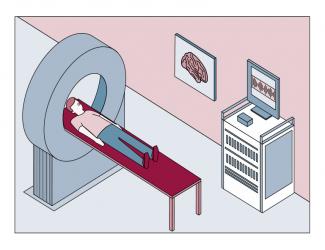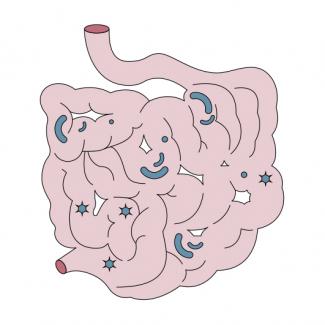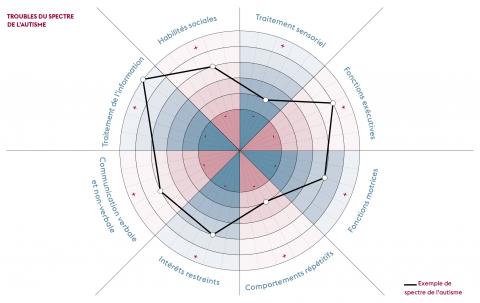
Understanding the heterogeneity of autism forms
This article was originally published in the latest issue of L'Édition N. 20.
Researchers at Université Paris-Saclay are working on a better understanding of autistic disorders and their emergence factors, as well as their diagnosis.
The Wild Child (1970), Rainman (1988), Forrest Gump (1994) and more recently The Specials (2019). Autism inspires cinema. However, can people with autism see themselves in the description of their disorder? Because much is still relatively unknown and understood about autism, around which the collective imagination crystallises certain representations. Indeed, this neurodevelopmental disorder, which affects one in 160 people worldwide, covers particular mental functions that are often difficult to characterise and the origin of which still raises questions. It also takes on a multitude of forms and manifestations. This is called Autism Spectrum Disorder (ASD). This is primarily characterised by deficits in social and communicative interactions, repetitive behaviours and restricted interests.
With an increase in the number of cases detected in recent decades, the issue of diagnosing autism remains one of the most delicate. This diagnosis is based on a summary of information provided by health professionals, after examinations which are mainly interviews or exercises carried out with the patient. However, these standardised instruments are questionable and are only an aid to clinical judgement. The evolution of the disorder is different for each person, which makes the medical diagnosis even more complex. The impact that this diagnosis has on the patient is not insignificant either: their designation as an autistic person influences their own psychic and social construction, the patient positioning themselves in relation to their status.
Understanding the causes of autistic traits helps to improve the medical examination, and consequently the diagnosis. Therefore, what avenues of research should be pursued to understand the factors of emergence, signs and diagnosis of ASD? Researchers at Université Paris-Saclay are making progress on these questions and are also proposing a range of possible approaches. Between neurodevelopmental approaches, microbiology and developmental epidemiology, their ambition is to understand the multidimensional aspect of autism.
Data science and open science in the diagnostic test
What if it were possible to predict autism from brain imaging techniques? Not to replace the diagnosis which is made after a clinical judgement, but to confirm it using MRI. This is what an international team of researchers is trying to demonstrate, some of whom are from the Paris-Saclay Center for Data Science (CDS) and the joint Inria-CEA Parietal team, from NeuroSpin (Univ. Paris-Saclay, CEA), to which the Physicist and Data Scientist Gaël Varoquaux belongs. Using an open science approach, since 2017, the members of this team have organised a challenge accessible to all volunteer data scientists with the aim of developing an ASD predictor. Using open Magnetic Resonance Imaging (MRI) data, the challenge was to submit the most optimal algorithms possible to predict the diagnosis of ASD. Over three months, 146 challengers put forward their algorithms, with a total of 720 submissions.
To check the validity of these algorithms, the teams supervising the challenge tested them on private MRI data. They obtained the ROC (Receiver Operating Characteristic) measure of the algorithm, i.e. the performance characteristic of this classifier, classifying elements into two groups, according to their characteristics. This is a measure of the quality of the predictions, which is substantiated in the form of a curve: the ROC curve, which gives the rate (between 0 and 1) of true positives (positive cases actually detected) and that (also between 0 and 1) of false positives (negative cases detected by mistake) for the classifier studied. Using the AUC (Area Under the Curve) located under the ROC curve the quality of the predictions is revealed. “The AUC gives us a kind of summary of all the possible decisions of our classifier,” explains Gaël Varoquaux. When the model succeeds in completely separating true positives from false positives, i.e. when the error rate is equivalent to zero, the performance is perfect. “The ideal curve therefore jumps from 0 to 1 and stabilises at 1.”
At the end of the challenge, the scientists combined the ten best algorithm models and produced a good predictor of ASD, with an AUC of 0.80, a good level of discrimination. The scientists compared the effectiveness of the screening test to the diagnostic test. While the first argues the presence (or absence) of a disease on the appearance (or not) of symptoms, the second estimates the probability of the existence of this disease. It is therefore positioned upstream of the pathology’s development. The predictor used as a screening test detects 88% of individuals with ASD, but at the cost of misclassifying 50% of controls. Used as a diagnostic test, the predictor detects 25% of individuals with ASD, but only 3% of controls are misclassified as patients. Although these results are still imperfect and incompatible with clinical application, they offer great hope for ASD prediction. However, MRI data are expensive and difficult to obtain for a large population. Research in this field is not easy, but this does not discourage Gaël Varoquaux: “We have shown that there is useful research for autism in this direction. An interesting approach would now be to scan two-year-olds, wait a few years for the doctor to confirm the ASD diagnosis, and then make a longitudinal prediction.” The information provided by the MRI performed on the child would make it possible to follow the progression of the disease over time and provide useful early biomarkers, in addition to the study of behaviours.
Neuroscience and the analysis of the heterogeneity of ASD
The multiplicity of forms of autism makes its diagnosis and analysis complex. The major symptoms of autism are often accompanied by various psychiatric or medical disorders, as well as various genetic and immune factors. This variability in the spectrum prevents reproducibility of the biomarkers identified between different individuals with ASD. Researchers from the NeuroSpin centre (Univ. Paris-Saclay, CEA) propose grouping people whose ASD are homogeneous. This separation into several groups aims to understand the biological mechanisms specific to each of them. Each group thus reveals behavioural differences associated with “cortical signatures” detected by MRI.
Because autism does not provide a homogeneous category of patients, it is a spectrum with a multitude of symptoms. To analyse the disease, a simple binary categorisation between “person with ASD” and “person without ASD” is not applicable here. Otherwise, individuals with widely different behaviours would be assimilated into the same group. The work of Angeline Mihailov and Neurospin’s Baobab team aims to distinguish individuals with ASD into multiple groups, which includes a “dimensional” approach, taking into consideration the type and degree of the patients’ symptoms.
MARIANNE Cohort: the influence of environmental factors
There is also debate about the factors that cause ASD. The genetic factor is the best known and most frequently observed. However, the increase in the prevalence of ASD in the world population over the past 30 years suggests that additional factors are at play. While improved diagnosis and broader definitions of autism are contributing to an increase in the number of patients testing positive, they do not explain everything. “This explains 50% of this increase, but it shifts the focus away from environmental factors, in which we had little interest, while models of neurodevelopmental disorders are highly developed,” explains Amaria Baghdadli, a Psychiatrist and Researcher at the Centre for Epidemiology and Population Health (CESP – Univ. Paris-Saclay, UVSQ, Inserm) and Head of the Autism Resource Centre at the Montpellier University Hospital. By ‘environmental factors’, the researcher means the natural, social, family and cultural environment. “The environment is able to leave its mark on our genome, our DNA. We then speak of ‘epigenetic imprinting’.”
Considering a multiplicity of factors at the origin of autism calls for a multidimensional approach. A project such as MARIANNE, which started in November 2022, is fully consistent with this. This project, coordinated by Amaria Baghdadli, has received six million euros in funding from the French Future Investment Plan (PIA). Its objective is to build a large research infrastructure by collecting data on 2,300 families. The aim is to establish the role of environmental and biological factors in the occurrence of an ASD or a neurodevelopmental disorder, in general. Unlike the previous cohort, ELENA, which focused on prognostic factors for ASD in children, MARIANNE is a prenatal cohort of children who are at significant risk of developing autism or other neurodevelopmental disorders because they have a sibling with autism.
The MARIANNE cohort includes two groups, one of pregnant women who have already had a child with autism and where the risk of having another child with developmental difficulties is greater, and the other where such a risk is almost zero, close to that of the general population. Pregnant women, fathers and children in the first group are monitored for six years. “The originality of our project comes first from its global health approach, where we are interested in general health and development, using a neurodevelopmental disorder’s model that is autism. Interdisciplinarity plays a major role because we use psychiatrists, paediatricians, gynaecologists, midwives, geneticists, social, environmental and developmental epidemiologists... Finally, we believe that such a model of non-genetic inheritance is at work in many chronic diseases and yet still needs to be studied further,” summarises Amaria Baghdadli.
The GEMMA project and the impact of intestinal microbiota
Determining how environmental factors influence the emergence of ASD sometimes requires a broader view of these troubles. At the Institute of Food Microbiology for Human Health (MICALIS – Univ. Paris-Saclay, INRAE, AgroParisTech), scientists are interested in the involvement of intestinal microbiota in certain aspects of ASD. The intestinal microbiota represents all the microorganisms (viruses, bacteria, parasites...) that populate the intestine and Léa Roussin, a doctoral student at MICALIS, confirms: “The scientific literature shows us that children with autism have a particular microbiota. In mouse models of autism, whether genetic, environmental or idiopathic, many studies point to a disruption of the gut microbiota compared to the considered ‘normal’ mice.”
The European research project GEMMA (Genome, Environment, Microbiome and Metabolome in Autism), which started in 2019 for five years and of which Léa Roussin’s thesis is a part, seeks to further these analyses. The project has a clinical ambition to detect predictive biomarkers for the development of ASD. It also includes a longitudinal study that consists in observing families with one child with ASD and a second child at a very young age, monitoring certain parameters in the latter (through blood, urine and immune system analyses, etc.) in order to determine what precedes the onset of ASD symptoms in children who will have them.
Another part of the project concerns the analysis of the influence of the microbiota of autistic children on the development of autistic-like symptoms in mouse models. “In my thesis, I am working on axenic mice born without intestinal microbiota. They live in a completely sterile environment, in an insulator,” explains Léa Roussin. For this research, the young researcher transfers the microbiota of human children with ASD to these mice. While these mice already exhibit altered behaviour, the goal is to observe if this microbiota has an additional impact on their behaviour. “Inflammation of the gut is seen in some ASD patients, which can affect the microbiota and contribute to the onset or aggravation of symptoms,” suggests Léa Roussin as a working hypothesis.
Given the impact that a diagnosis has on a child’s and even an adult’s life, research into autism spectrum disorders is essential. This fresco of autism, which has been in black and white for too long, is now beginning to move into colour.
Publications :
- Mihailov, A., Philippe, C., Gloaguen, A. et al. Cortical signatures in behaviorally clustered autistic traits subgroups: a population-based study. Translational psychiatry 10, 207, (2020).
- Roussin L., Prince N., Perez-Pardo P., Kraneveld AD, Rabot S, Naudon L.. Role of the gut microbiota in the pathophysiology of autism spectrum disorder: clinical and preclinical evidence. Microorganisms, vol. 8 (9), (2020).
- N. Traut, G. Varoquaux et al. Insights from an autism imaging biomarker challenge: Promises and threats to biomarker discovery. NeuroImage, vol. 255, (2022).



